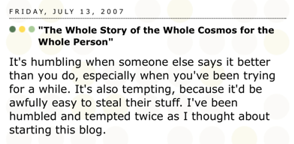
Into the Cloud
"You do not know how the wind blows," says Ecclesiastes. Nor, I would add, how the internet does. So I heed his advice: "In the morning, sow your seed. Until evening, do not cease from labor. For of any two things you do not know which will succeed."
This website commends to the wind—and to the “cloud” they call the internet—much of the work I have done on lives, memories, legacies, and stories. Some of the books can be now be read in their entirety--free of charge--through Google Books. Most of the others allow substantial partial views. The complete PBS series, Seasons of Life, can also be seen and all the connected audio heard. Certain articles are available as PDFs.
"There is nothing new under the sun," was Ecclesiastes' lament. But the poet Wislawa Szymborska, a Nobel laureate, would have none of it. “You yourself were born new under the sun,” she tells Ecclesiastes...
And the poem you created is also new under the sun, since no one wrote it down before you. And all your readers are also new under the sun, since those who lived before you couldn't read your poem. And that cypress you're sitting under hasn't been growing since the dawn of time...
And, Ecclesiastes, I'd also like to ask you what new thing under the sun you're planning to work on now? A further supplement to the thoughts you've already expressed? Or maybe you're tempted to contradict some of them now. Have you taken notes yet, do you have drafts? I doubt you'll say, "I've written everything down, I've got nothing left to add."
The Evolution of Teilhard de Chardin



So there are indeed things to add. A set of books, first of all, to accompany Teilhard: Visionary Scientist, a documentary film that premiered in 2024. A century ago, in the shadow of two Great Wars, the priest and paleontologist Pierre Teilhard de Chardin gave birth to a new vision of the earth, challenging a Christian narrative that had compelled belief for thousands of years. He told the story of a planet flowing from an origin in Matter to a destination in Spirit. A planet evolving. It would be home to a new kind of human.
Each of the books in the set –– The Earth He Loved, The Women He Knew, and The Story He Told –– follows a distinct path through Teilhard’s life, from beginning to end, taking you to places the others do not, but also to places where paths meet. They are available in both print and digital formats, as singles or a box set entitled A Teilhard Trilogy. I’ve also created a set of five-minute videos called Moments in the Life of Teilhard de Chardin—something for conversation as well as contemplation.
The Story of Everything
The Story of Everything is a tale of creation and evolution—a “philosophical parable,” if you will. It’s about quarks and bugs and spirits and stars, not to mention science, religion, and philosophy. So it’s longer than most parables. But it’s not that complicated. There's a Speaker. There's a Story. Each has a life. Each makes a journey. “You come from the breath of God,” a boy is told at the beginning of his life. “You come from stardust,” he says at the end. But his is not the last word. More is said in a related blog.
The Idea Waiting To Be Born



The Idea Waiting To Be Born is a parable based on the Ten Oxherding Pictures of Zen Buddhism. I tell the story as a Westerner answering an invitation to simply look at the pictures. The story that results is one in which Spirit does not come down from above but rises up from below. The events create a path through the creative process.
Ancestral Help


In a book called White Gloves I described autobiographical memory as both a keeper of archives and a maker of myth, one laboring by day, the other by night. Together, they fashion a life narrative that reveals a self, even creates a self.
Later, I tried to illustrate how we put memory to another use: creating ancestors. The story of the white gloves is a perfect example: here memory creates a grandfather with a soul for art, a soul he sacrifices for his family. In the 5-minute audio, "A Family Remembers," a family’s four generations make a hero of their deceased great-grandfather, an epic of his escape from massacre. “This guy survived that great attack,” a descendant says. “I’m going to survive.” In the storytelling you can hear the mythmaker at work, creating ancestral help.
Is It True?


There comes a point when listening to a life story when you ask yourself, how much of this is true? Truth is not a simple notion, as I suggested in a talk at the University of Sao Paulo. Historical truth is not narrative truth, the keeper of archives not the maker of myth.
Each kind of truth has its own methods of verification. The critical moment for narrative truth comes when the story you’ve fashioned is shown to its teller.

